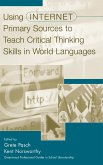- Broschiertes Buch
- Merkliste
- Auf die Merkliste
- Bewerten Bewerten
- Teilen
- Produkt teilen
- Produkterinnerung
- Produkterinnerung
The Rowman & Littlefield Handbook for Critical Thinking provides a quick and authoritative reference for issues regarding reasoning, and provides clear and succinct discussions of issues such as counterfactuals, rational decision-making, and critical thinking in writing.
Andere Kunden interessierten sich auch für
![Rowman & Littlefield Guide to Writing with Sources Rowman & Littlefield Guide to Writing with Sources]() James P. DavisRowman & Littlefield Guide to Writing with Sources21,99 €
James P. DavisRowman & Littlefield Guide to Writing with Sources21,99 €![Critical and Creative Thinking Critical and Creative Thinking]() Critical and Creative Thinking113,99 €
Critical and Creative Thinking113,99 €![Stop Thinking About Writing ... Just Write Stop Thinking About Writing ... Just Write]() Allison DukeStop Thinking About Writing ... Just Write9,99 €
Allison DukeStop Thinking About Writing ... Just Write9,99 €![Hard Thinking Hard Thinking]() John D. MullenHard Thinking77,99 €
John D. MullenHard Thinking77,99 €![Using Internet Primary Sources to Teach Critical Thinking Skills in World Languages Using Internet Primary Sources to Teach Critical Thinking Skills in World Languages]() Grete PaschUsing Internet Primary Sources to Teach Critical Thinking Skills in World Languages67,99 €
Grete PaschUsing Internet Primary Sources to Teach Critical Thinking Skills in World Languages67,99 €![Critical Thinking for English-Language Learners Critical Thinking for English-Language Learners]() Christopher M. JohnsonCritical Thinking for English-Language Learners179,99 €
Christopher M. JohnsonCritical Thinking for English-Language Learners179,99 €![THINKING THROUGH WRITING THINKING THROUGH WRITING]() Susan R. HortonTHINKING THROUGH WRITING30,99 €
Susan R. HortonTHINKING THROUGH WRITING30,99 €-
-
-
The Rowman & Littlefield Handbook for Critical Thinking provides a quick and authoritative reference for issues regarding reasoning, and provides clear and succinct discussions of issues such as counterfactuals, rational decision-making, and critical thinking in writing.
Produktdetails
- Produktdetails
- Verlag: Rowman & Littlefield Publishers
- Seitenzahl: 168
- Erscheinungstermin: 8. Februar 2008
- Englisch
- Abmessung: 229mm x 152mm x 9mm
- Gewicht: 254g
- ISBN-13: 9780742559790
- ISBN-10: 0742559793
- Artikelnr.: 23306202
- Herstellerkennzeichnung
- Libri GmbH
- Europaallee 1
- 36244 Bad Hersfeld
- gpsr@libri.de
- Verlag: Rowman & Littlefield Publishers
- Seitenzahl: 168
- Erscheinungstermin: 8. Februar 2008
- Englisch
- Abmessung: 229mm x 152mm x 9mm
- Gewicht: 254g
- ISBN-13: 9780742559790
- ISBN-10: 0742559793
- Artikelnr.: 23306202
- Herstellerkennzeichnung
- Libri GmbH
- Europaallee 1
- 36244 Bad Hersfeld
- gpsr@libri.de
Noel Hendrickson is associate professor and a founding faculty member of the Intelligence Analysis Program at James Madison University. He earned a PhD in Philosophy from the University of Wisconsin-Madison, and has over a decade of experience teaching reasoning methods to aspiring intelligence analysts.
Part 1 Introduction
Part 2 Chapter 1: Word Hazards: Statements, Ambiguity, and Vagueness
Chapter 3 A Logical Digression: Propositional Attitudes
Part 4 Chapter 2: Complex Passages: Descriptions, Explanations, and
Arguments
Chapter 5 Odd words
Chapter 6 A Logical Digression: How not to distinguish induction from
deduction, or why the valid/inductive distinction is better
Part 7 Chapter 3: Finding Arguments
Part 8 Chapter 4: Grounding Statements in Fact: Observation, Testimony, and
Other Arguments based upon Criteria
Chapter 9 Criteria for evaluating observation statements
Chapter 10 Criteria for evaluating testimony
Part 11 Chapter 5: Deduction: Categorical Syllogisms
Chapter 12 Conversion, Obversion, Contraposition
Chapter 13 Categorical Syllogisms
Chapter 14 a. A Logical Digression: Venn Diagrams
Chapter 15 b. A Logical Digression: Conditional Validity
Chapter 16 c. Odd Words
Chapter 17 Enthymemes
Part 18 Chapter 6: Arguments Based upon Propositions
Chapter 19 Statement Forms
Chapter 20 a. A Logical Digression: Symbols and Truth Table Definitions
Chapter 21 Argument Forms
Chapter 22 a. Logical Digression: Truth Tables for Testing the Validity of
Arguments
Chapter 23 b. Odd Words: Tautology, Contradiction, Contingent Statement
Chapter 24 Logical Equivalences
Chapter 25 a. A Logical Digression: Demonstrating the Equivalences with
Truth Tables
Part 26 Chapter 7: Probability Calculations
Chapter 27 Theories of Probability
Chapter 28 a. Odd Words: Relative Frequency and Subjective Theories
Chapter 29 Rules of Probability
Part 30 Chapter 8: Generalizations and Particularizations
Chapter 31 Generalization Arguments
Chapter 32 a. A Logical Digression: Surveys and Opinion Polls
Chapter 33 Particularization Arguments
Part 34 Chapter 9: Analogical Arguments
Chapter 35 Analogical Arguments
Chapter 36 a. A Logical Digression: Analogical Arguments vs. Generalization
and Particularization Arguments
Part 37 Chapter 10: Evaluating Hypotheses: Inference to Best Explanation
Chapter 38 Likelihood
Chapter 39 Explanatory Power
Chapter 40 Simplicity
Chapter 41 Novelty
Chapter 42 Appropriate Explanatory Content
Chapter 43 Summary of Factors in Evaluating Explanatory Inferences
Chapter 44 Explanatory Inferences, Confirmation, Disconfirmation, and
Bayes's Theorem
Part 45 Chapter 11: Causal Inferences
Chapter 46 Mill's Methods of Causal Inference
Chapter 47 Probabilistic Method of Causal Inference
Chapter 48 Counterfactual Method of Causal Inference
Part 49 Chapter 12: Counterfactual Reasoning
Chapter 50 Supporting Counterfactual Claims
Chapter 51 a. A Logical Digression: Counterfactual Fallacies
Part 52 Chapter 13: Decisions Under Risk
Chapter 53 Utility
Chapter 54 Decision-Making Under Risk With One Factor
Chapter 55 Decision-Making Under Risk With Multiple Factors
Part 56 Chapter 14: Decisions Under Uncertainty
Chapter 57 Universal Principles for Decisions Under Uncertainty
Chapter 58 Further Principles for Decisions Under Multilateral Uncertainty
Chapter 59 Further Principles for Decisions Under Unilateral Uncertainty
Part 60 Chapter 15: Informal Fallacies
Chapter 61 Fallacies of Ambiguity
Chapter 62 Fallacies of Relevance
Chapter 63 Fallacies of Presumption
Chapter 64 Fallacies of Weak Induction
Part 65 Chapter 16: Critical Writing: An Audience-Centered Approach to
Critical Thinking
Chapter 66 Examining Critical Writing: A Rhetorical Approach
Chapter 67 Selecting the Appropriate Forum
Chapter 68 Establishing Presentation Objectives
Chapter 69 Establishing Initial Credibility
Chapter 70 Screening Content for Inclusion
Chapter 71 Considering Sources of Information
Chapter 72 Identifying Content Areas
Chapter 73 Grouping Information for Readers
Chapter 74 Organizing Information within the Forum
Chapter 75 Externalizing Ideas: A Final Perspective
Part 76 Bibliography
Part 2 Chapter 1: Word Hazards: Statements, Ambiguity, and Vagueness
Chapter 3 A Logical Digression: Propositional Attitudes
Part 4 Chapter 2: Complex Passages: Descriptions, Explanations, and
Arguments
Chapter 5 Odd words
Chapter 6 A Logical Digression: How not to distinguish induction from
deduction, or why the valid/inductive distinction is better
Part 7 Chapter 3: Finding Arguments
Part 8 Chapter 4: Grounding Statements in Fact: Observation, Testimony, and
Other Arguments based upon Criteria
Chapter 9 Criteria for evaluating observation statements
Chapter 10 Criteria for evaluating testimony
Part 11 Chapter 5: Deduction: Categorical Syllogisms
Chapter 12 Conversion, Obversion, Contraposition
Chapter 13 Categorical Syllogisms
Chapter 14 a. A Logical Digression: Venn Diagrams
Chapter 15 b. A Logical Digression: Conditional Validity
Chapter 16 c. Odd Words
Chapter 17 Enthymemes
Part 18 Chapter 6: Arguments Based upon Propositions
Chapter 19 Statement Forms
Chapter 20 a. A Logical Digression: Symbols and Truth Table Definitions
Chapter 21 Argument Forms
Chapter 22 a. Logical Digression: Truth Tables for Testing the Validity of
Arguments
Chapter 23 b. Odd Words: Tautology, Contradiction, Contingent Statement
Chapter 24 Logical Equivalences
Chapter 25 a. A Logical Digression: Demonstrating the Equivalences with
Truth Tables
Part 26 Chapter 7: Probability Calculations
Chapter 27 Theories of Probability
Chapter 28 a. Odd Words: Relative Frequency and Subjective Theories
Chapter 29 Rules of Probability
Part 30 Chapter 8: Generalizations and Particularizations
Chapter 31 Generalization Arguments
Chapter 32 a. A Logical Digression: Surveys and Opinion Polls
Chapter 33 Particularization Arguments
Part 34 Chapter 9: Analogical Arguments
Chapter 35 Analogical Arguments
Chapter 36 a. A Logical Digression: Analogical Arguments vs. Generalization
and Particularization Arguments
Part 37 Chapter 10: Evaluating Hypotheses: Inference to Best Explanation
Chapter 38 Likelihood
Chapter 39 Explanatory Power
Chapter 40 Simplicity
Chapter 41 Novelty
Chapter 42 Appropriate Explanatory Content
Chapter 43 Summary of Factors in Evaluating Explanatory Inferences
Chapter 44 Explanatory Inferences, Confirmation, Disconfirmation, and
Bayes's Theorem
Part 45 Chapter 11: Causal Inferences
Chapter 46 Mill's Methods of Causal Inference
Chapter 47 Probabilistic Method of Causal Inference
Chapter 48 Counterfactual Method of Causal Inference
Part 49 Chapter 12: Counterfactual Reasoning
Chapter 50 Supporting Counterfactual Claims
Chapter 51 a. A Logical Digression: Counterfactual Fallacies
Part 52 Chapter 13: Decisions Under Risk
Chapter 53 Utility
Chapter 54 Decision-Making Under Risk With One Factor
Chapter 55 Decision-Making Under Risk With Multiple Factors
Part 56 Chapter 14: Decisions Under Uncertainty
Chapter 57 Universal Principles for Decisions Under Uncertainty
Chapter 58 Further Principles for Decisions Under Multilateral Uncertainty
Chapter 59 Further Principles for Decisions Under Unilateral Uncertainty
Part 60 Chapter 15: Informal Fallacies
Chapter 61 Fallacies of Ambiguity
Chapter 62 Fallacies of Relevance
Chapter 63 Fallacies of Presumption
Chapter 64 Fallacies of Weak Induction
Part 65 Chapter 16: Critical Writing: An Audience-Centered Approach to
Critical Thinking
Chapter 66 Examining Critical Writing: A Rhetorical Approach
Chapter 67 Selecting the Appropriate Forum
Chapter 68 Establishing Presentation Objectives
Chapter 69 Establishing Initial Credibility
Chapter 70 Screening Content for Inclusion
Chapter 71 Considering Sources of Information
Chapter 72 Identifying Content Areas
Chapter 73 Grouping Information for Readers
Chapter 74 Organizing Information within the Forum
Chapter 75 Externalizing Ideas: A Final Perspective
Part 76 Bibliography
Part 1 Introduction
Part 2 Chapter 1: Word Hazards: Statements, Ambiguity, and Vagueness
Chapter 3 A Logical Digression: Propositional Attitudes
Part 4 Chapter 2: Complex Passages: Descriptions, Explanations, and
Arguments
Chapter 5 Odd words
Chapter 6 A Logical Digression: How not to distinguish induction from
deduction, or why the valid/inductive distinction is better
Part 7 Chapter 3: Finding Arguments
Part 8 Chapter 4: Grounding Statements in Fact: Observation, Testimony, and
Other Arguments based upon Criteria
Chapter 9 Criteria for evaluating observation statements
Chapter 10 Criteria for evaluating testimony
Part 11 Chapter 5: Deduction: Categorical Syllogisms
Chapter 12 Conversion, Obversion, Contraposition
Chapter 13 Categorical Syllogisms
Chapter 14 a. A Logical Digression: Venn Diagrams
Chapter 15 b. A Logical Digression: Conditional Validity
Chapter 16 c. Odd Words
Chapter 17 Enthymemes
Part 18 Chapter 6: Arguments Based upon Propositions
Chapter 19 Statement Forms
Chapter 20 a. A Logical Digression: Symbols and Truth Table Definitions
Chapter 21 Argument Forms
Chapter 22 a. Logical Digression: Truth Tables for Testing the Validity of
Arguments
Chapter 23 b. Odd Words: Tautology, Contradiction, Contingent Statement
Chapter 24 Logical Equivalences
Chapter 25 a. A Logical Digression: Demonstrating the Equivalences with
Truth Tables
Part 26 Chapter 7: Probability Calculations
Chapter 27 Theories of Probability
Chapter 28 a. Odd Words: Relative Frequency and Subjective Theories
Chapter 29 Rules of Probability
Part 30 Chapter 8: Generalizations and Particularizations
Chapter 31 Generalization Arguments
Chapter 32 a. A Logical Digression: Surveys and Opinion Polls
Chapter 33 Particularization Arguments
Part 34 Chapter 9: Analogical Arguments
Chapter 35 Analogical Arguments
Chapter 36 a. A Logical Digression: Analogical Arguments vs. Generalization
and Particularization Arguments
Part 37 Chapter 10: Evaluating Hypotheses: Inference to Best Explanation
Chapter 38 Likelihood
Chapter 39 Explanatory Power
Chapter 40 Simplicity
Chapter 41 Novelty
Chapter 42 Appropriate Explanatory Content
Chapter 43 Summary of Factors in Evaluating Explanatory Inferences
Chapter 44 Explanatory Inferences, Confirmation, Disconfirmation, and
Bayes's Theorem
Part 45 Chapter 11: Causal Inferences
Chapter 46 Mill's Methods of Causal Inference
Chapter 47 Probabilistic Method of Causal Inference
Chapter 48 Counterfactual Method of Causal Inference
Part 49 Chapter 12: Counterfactual Reasoning
Chapter 50 Supporting Counterfactual Claims
Chapter 51 a. A Logical Digression: Counterfactual Fallacies
Part 52 Chapter 13: Decisions Under Risk
Chapter 53 Utility
Chapter 54 Decision-Making Under Risk With One Factor
Chapter 55 Decision-Making Under Risk With Multiple Factors
Part 56 Chapter 14: Decisions Under Uncertainty
Chapter 57 Universal Principles for Decisions Under Uncertainty
Chapter 58 Further Principles for Decisions Under Multilateral Uncertainty
Chapter 59 Further Principles for Decisions Under Unilateral Uncertainty
Part 60 Chapter 15: Informal Fallacies
Chapter 61 Fallacies of Ambiguity
Chapter 62 Fallacies of Relevance
Chapter 63 Fallacies of Presumption
Chapter 64 Fallacies of Weak Induction
Part 65 Chapter 16: Critical Writing: An Audience-Centered Approach to
Critical Thinking
Chapter 66 Examining Critical Writing: A Rhetorical Approach
Chapter 67 Selecting the Appropriate Forum
Chapter 68 Establishing Presentation Objectives
Chapter 69 Establishing Initial Credibility
Chapter 70 Screening Content for Inclusion
Chapter 71 Considering Sources of Information
Chapter 72 Identifying Content Areas
Chapter 73 Grouping Information for Readers
Chapter 74 Organizing Information within the Forum
Chapter 75 Externalizing Ideas: A Final Perspective
Part 76 Bibliography
Part 2 Chapter 1: Word Hazards: Statements, Ambiguity, and Vagueness
Chapter 3 A Logical Digression: Propositional Attitudes
Part 4 Chapter 2: Complex Passages: Descriptions, Explanations, and
Arguments
Chapter 5 Odd words
Chapter 6 A Logical Digression: How not to distinguish induction from
deduction, or why the valid/inductive distinction is better
Part 7 Chapter 3: Finding Arguments
Part 8 Chapter 4: Grounding Statements in Fact: Observation, Testimony, and
Other Arguments based upon Criteria
Chapter 9 Criteria for evaluating observation statements
Chapter 10 Criteria for evaluating testimony
Part 11 Chapter 5: Deduction: Categorical Syllogisms
Chapter 12 Conversion, Obversion, Contraposition
Chapter 13 Categorical Syllogisms
Chapter 14 a. A Logical Digression: Venn Diagrams
Chapter 15 b. A Logical Digression: Conditional Validity
Chapter 16 c. Odd Words
Chapter 17 Enthymemes
Part 18 Chapter 6: Arguments Based upon Propositions
Chapter 19 Statement Forms
Chapter 20 a. A Logical Digression: Symbols and Truth Table Definitions
Chapter 21 Argument Forms
Chapter 22 a. Logical Digression: Truth Tables for Testing the Validity of
Arguments
Chapter 23 b. Odd Words: Tautology, Contradiction, Contingent Statement
Chapter 24 Logical Equivalences
Chapter 25 a. A Logical Digression: Demonstrating the Equivalences with
Truth Tables
Part 26 Chapter 7: Probability Calculations
Chapter 27 Theories of Probability
Chapter 28 a. Odd Words: Relative Frequency and Subjective Theories
Chapter 29 Rules of Probability
Part 30 Chapter 8: Generalizations and Particularizations
Chapter 31 Generalization Arguments
Chapter 32 a. A Logical Digression: Surveys and Opinion Polls
Chapter 33 Particularization Arguments
Part 34 Chapter 9: Analogical Arguments
Chapter 35 Analogical Arguments
Chapter 36 a. A Logical Digression: Analogical Arguments vs. Generalization
and Particularization Arguments
Part 37 Chapter 10: Evaluating Hypotheses: Inference to Best Explanation
Chapter 38 Likelihood
Chapter 39 Explanatory Power
Chapter 40 Simplicity
Chapter 41 Novelty
Chapter 42 Appropriate Explanatory Content
Chapter 43 Summary of Factors in Evaluating Explanatory Inferences
Chapter 44 Explanatory Inferences, Confirmation, Disconfirmation, and
Bayes's Theorem
Part 45 Chapter 11: Causal Inferences
Chapter 46 Mill's Methods of Causal Inference
Chapter 47 Probabilistic Method of Causal Inference
Chapter 48 Counterfactual Method of Causal Inference
Part 49 Chapter 12: Counterfactual Reasoning
Chapter 50 Supporting Counterfactual Claims
Chapter 51 a. A Logical Digression: Counterfactual Fallacies
Part 52 Chapter 13: Decisions Under Risk
Chapter 53 Utility
Chapter 54 Decision-Making Under Risk With One Factor
Chapter 55 Decision-Making Under Risk With Multiple Factors
Part 56 Chapter 14: Decisions Under Uncertainty
Chapter 57 Universal Principles for Decisions Under Uncertainty
Chapter 58 Further Principles for Decisions Under Multilateral Uncertainty
Chapter 59 Further Principles for Decisions Under Unilateral Uncertainty
Part 60 Chapter 15: Informal Fallacies
Chapter 61 Fallacies of Ambiguity
Chapter 62 Fallacies of Relevance
Chapter 63 Fallacies of Presumption
Chapter 64 Fallacies of Weak Induction
Part 65 Chapter 16: Critical Writing: An Audience-Centered Approach to
Critical Thinking
Chapter 66 Examining Critical Writing: A Rhetorical Approach
Chapter 67 Selecting the Appropriate Forum
Chapter 68 Establishing Presentation Objectives
Chapter 69 Establishing Initial Credibility
Chapter 70 Screening Content for Inclusion
Chapter 71 Considering Sources of Information
Chapter 72 Identifying Content Areas
Chapter 73 Grouping Information for Readers
Chapter 74 Organizing Information within the Forum
Chapter 75 Externalizing Ideas: A Final Perspective
Part 76 Bibliography









